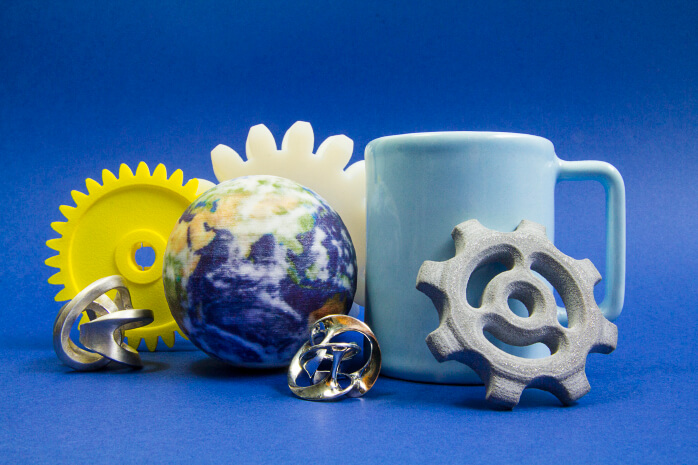This is a guest post in our series looking at the future of 3D Printing. To celebrate 5 years of reporting on the 3D printing industry, we’ve invited industry leaders and 3D printing experts to give us their perspective and predictions for the next 5 years and insight into trends in additive manufacturing.
Nora Toure is the Business Development Director at Sculpteo, a leading digital manufacturing specialist based in Paris and San Francisco, and the founder of Women in 3D Printing, an organization dedicated to promoting, supporting and inspiring women who are using Additive Manufacturing technologies.
3D Printing: The Next 5 Years by Nora Toure
When I look at the diversity of Additive Manufacturing applications that emerged over the last 5 years, I wonder if it is possible at all to predict what’s coming for the next 5 years!
And the reason for so many innovations is that 3D Printing is a transverse technology, applicable to almost all other industries. At the very same time, 3D Printing is a manufacturing tool. It can sometimes be difficult to know what we’re looking at: a new technology (which would explain the crave we’ve seen for this technology in the past 10 years), or a not-so-new manufacturing tool?
In my opinion, what is interesting with the development of technologies since the 90s is that they are now becoming accessible way faster than what is used to be. 3D Printing is what it is today only because we had the Internet, and a handful of tools to build websites easily (Shopify, WordPress…), but also tools to build apps, learn directly online (Udemy, Instructables, Adafruit, Udacity just to name a few), and now…tools to manufacture.

Making tech accessible to all
Thanks to all those tools, and the fact that people can communicate with almost everybody and anybody online and collaborate across the world, you literally do not need a PhD in Sciences or Design to innovate, design, and manufacture your product. And that’s the key here to what’s happened in the last 10 years in 3D Printing, and what will continue to happen over the next 5+ years in Additive Manufacturing: more diverse minds have access to Tech and can innovate.
That’s new. Innovation has always been a privilege lab-rat thing, and now, we can all innovate in our own industries and specializations.
The next 5 years for 3D Printing, I believe, will be full of cross-technologies innovations: We start seeing 3D Printing related to VR/AR applications, but imagine what 3D Printing + AI could bring us, or 3D Printing + Industry 4.0, domotic, biology, nanotechnologies….? I do not have a real answer to the question of what 3D Printing will look like in 5 years but I can already see some amazing things happening today that are setting the ground for innovation up to 2022.
Laura Hockaday, with the Institute of Cell Dynamics and Imaging in Germany is for example working on understanding how living cells behave and function in a 3D printed tissue. Who knows what her discoveries and those from others in this field will mean for 3D Bioprinting?
I do also think that the revolution in Fashion and Wearables is most likely to continue, with more custom-fit clothes. I know a few amazing women working on those questions. I’d recommend looking into what Claire Chabaud is doing in France with Endeer, and Stephania Stefanakou with House of Anesi in the US.
![[L-R] Nora Toure, Barbara Hanna, Pauline Eveno, Cassandra Delage and Claire Chabaud during 3DTalk Paris. Photo via Women in 3D Printing.](https://3dprintingindustry.com/wp-content/uploads/2017/04/Nora-Toure-Barbara-Hanna-Pauline-Eveno-Cassandra-Delage-and-Claire-during-3DTalk-Paris.-Photo-via-Women-in-3D-Printing..jpg)
3D printing for the healthcare sector and beyond
Healthcare is a big one too. Almost each time I ask about the most impactful or impressive use of 3D Printing, people refer to a healthcare application they’ve been reading about lately. While the few medical-related 3D Printing use-cases are usually impressive, it will come as no surprise for the professional of both industries that in reality Healthcare and 3D Printing words don’t know each other very well. Jenny Chen, from 3DHeals is publishing annual State of 3D Printing in Healthcare reports. I recommend keeping an eye on those as we are only starting to deep our toes in the potential of 3D Printing applied to Healthcare.

And I am not even talking about 3D Printing in space which is likely to become a standard over the next 5 years.
I personally hope we will also see innovations in terms of materials that can be 3D Printed with recycling options. A few companies are already working on the topic and I’ll be following them to see where this goes.
But let’s not forget that 3D Printing will also continue to “simply” enable people to improve their lives and businesses, such as Afoma’s: 3DAfrica is working with Afoma, the owner of a hair salon in Nigeria to design a 3D printed rechargeable, detachable, cordless hair dryer. Now, instead of traveling to China every year to purchase in bulk, she produces these in her shop, prints and customizes as needed, and sells to other cosmetologists.
We will definitely continue to have more of this over the next 5 years.
This is a guest post in our series looking at the future of 3D Printing, if you’d like to participate in this series then contact us for more information. For more insights into the 3D printing industry, sign up to our newsletter and follow our active social media channels.
Don’t forget that you can vote now in the 1st annual 3D Printing Industry Awards.
Can you find more information here about Sculpteo and Women in 3D Printing.
Featured image shows Nora Toure speaking about 3D Printing as a service at Bespoke, San Francisco. Photo via Women in 3D Printing.



